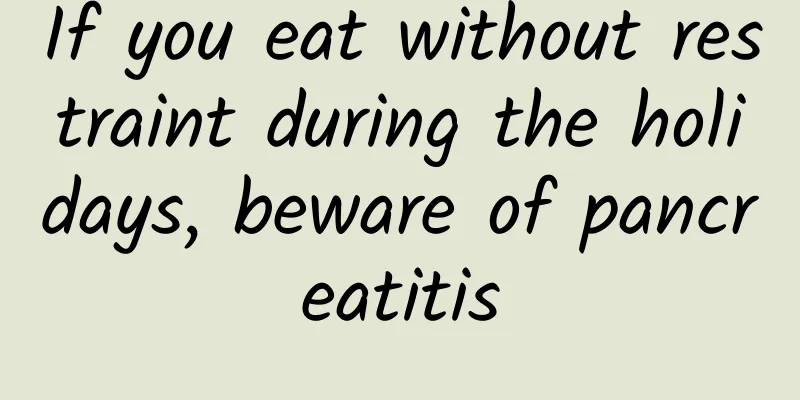If you eat without restraint during the holidays, beware of pancreatitis

|
Author: Wang Jinmei Zhengzhou Central Hospital Reviewer: Zhang Kai, Deputy Director Pharmacist, Zhengzhou Central Hospital Holidays are a great time to relax! Meet up with friends, eat a lot of fish and meat, and eat and drink a lot. You think you are taking in "high-quality nutrients", but you never expected that pancreatitis has quietly come to visit you. Why does excessive eating easily induce pancreatitis? What symptoms should alert you to pancreatitis? How to treat it? How can we prevent it in daily life? If you want to know more, keep reading! The pancreas is a long and narrow gland, which is placed horizontally on the plane of the 1st to 2nd lumbar vertebrae of the posterior abdominal wall. It is soft, gray-red, and 12 to 15 cm long. It is the second largest digestive gland in the human body and has two major functions in the human body: first, it is responsible for exocrine secretion, neutralizing gastric acid, and digesting proteins, fats, and carbohydrates; second, it is responsible for endocrine secretion and regulating blood sugar. Why is it easy to induce pancreatitis if you eat without restraint? The reason is that eating and drinking indiscriminately during the holidays will stimulate the pancreas to secrete a large amount of pancreatic juice, increase the pressure in the pancreatic duct, rupture the pancreatic bubbles, and overflow the pancreatic enzymes, causing self-digestion, edema, bleeding, and even necrosis of the pancreatic tissue, thus leading to the occurrence of acute pancreatitis. If pancreatic inflammation recurs, it will eventually lead to chronic pancreatitis. Figure 1 Copyright image, no permission to reprint 1. Clinical manifestations of pancreatitis During an acute attack of pancreatitis, abdominal pain will occur, which is generally manifested as sharp or dull pain, and is persistent and severe, mostly in the upper abdomen, followed by the left upper abdomen, and can radiate to the chest, back, and left abdomen. Patients usually find it difficult to endure, and the pain lasts for more than 24 hours without relief. Symptoms may be relieved in some patients when they are in a curled-up position or leaning forward. At the same time, patients may experience nausea, vomiting, fever, abdominal distension, jaundice, changes in consciousness, etc. Therefore, once the above symptoms appear, especially after overeating, be sure to be alert to the occurrence of acute pancreatitis and seek medical attention in time to avoid worsening of the disease. Chronic pancreatitis patients are also more common in clinical practice, mainly manifested by repeated or persistent abdominal pain, nausea, vomiting, fever, diarrhea, malnutrition, abdominal masses, etc. Figure 2 Copyright image, no permission to reprint 2. How to treat pancreatitis? Acute pancreatitis progresses rapidly and has many complications. Comprehensive treatment should be carried out during the acute reaction period of the patient to prevent organ dysfunction and reduce mortality. Treatment mainly includes: early fluid resuscitation, analgesia and sedation, anti-infection, inhibition of pancreatic secretion, nutritional support therapy, organ function support, and treatment of local complications. Chronic pancreatitis includes general treatment (quitting smoking, quitting drinking, controlling diet, exercising appropriately), internal medicine treatment (pain relief, exogenous pancreatic enzyme replacement therapy, etc.), endoscopic interventional treatment, surgical treatment, etc. Figure 3 Copyright image, no permission to reprint 3. How to prevent pancreatitis? The occurrence of pancreatitis is closely related to our living habits. We must pay attention to our eating habits and life patterns in our daily lives, so that various diseases including pancreatitis can be kept away. 1. Reduce fat intake: To prevent pancreatitis, you must reduce fat intake and avoid overeating, which may cause pancreatitis by making food difficult to digest. 2. It is recommended to eat small meals frequently: eating too much, or eating foods that are difficult to digest, spicy or irritating, will increase the secretion of gastric juice, increase the burden on the pancreas, and cause pancreatitis. 3. Ensure balanced nutrition: Chronic pancreatitis is prone to fatty diarrhea, and patients are prone to malnutrition. They should eat nutritious foods such as lean meat, fish, tofu, etc., carbohydrates such as rice and noodles, and fresh vegetables should be eaten more appropriately. 4. Avoid drinking alcohol: Alcohol itself can directly damage the pancreas, and can also indirectly stimulate the secretion of pancreatic juice, opening the door for pancreatic juice to enter the pancreatic tissue. Therefore, it is necessary to avoid drinking alcohol to prevent pancreatitis. |
<<: Be careful when working at a desk, or you may get this disease
Recommend
What is an ovarian solid mass?
A solid ovarian mass usually refers to an ovarian...
When you reach middle age, you should be careful when drinking tea. You should master the three things to drink and the three things not to drink. Only by drinking tea can you be healthy.
At forty, people are free from doubts. People of ...
What are the harms of abortion to the human body?
Everyone is familiar with abortion, thanks to the...
What is the difference between pregnancy chest pain and premenstrual chest pain?
Breast pain is one of the most troubling problems...
How to delay menstruation for a few years
Women's menstrual period refers to the monthl...
A little pain in the lower body
When some people experience a dull pain in their ...
Vaccines that women must take
The vaccine that women must take is usually the H...
What to do if you have mastitis during lactation?
Many women are susceptible to adenitis during the...
Overview of gynecological mycoplasma infection
Gynecological diseases are something that people ...
What are the causes of vulvar itching after menstruation?
I believe that many women have such situations in...
Women dream of that place becoming bigger and firmer
Firm, full and sexy breasts are the bargaining ch...
What should I do to prepare for pregnancy?
With the rapid development of society, our living...
Why do I get a migraine when my period comes?
Women will experience many symptoms during their ...









